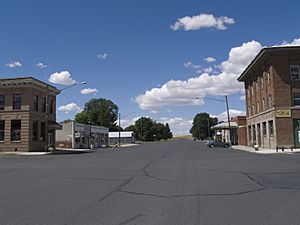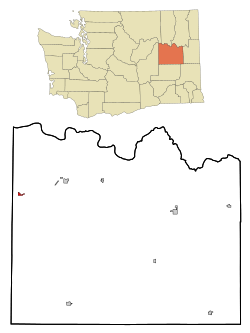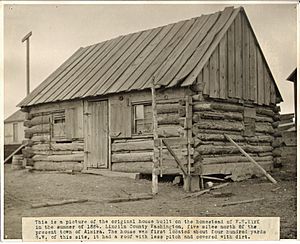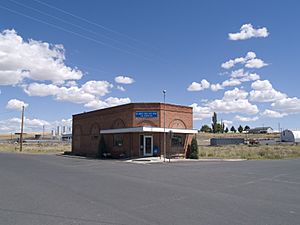Almira, Washington facts for kids
Quick facts for kids
Almira
|
|
|---|---|
| Almira, Washington | |

Downtown Almira in 2008
|
|

Location of Almira, Washington
|
|
| Country | United States |
| State | Washington |
| County | Lincoln |
| Area | |
| • Total | 0.51 sq mi (1.33 km2) |
| • Land | 0.51 sq mi (1.33 km2) |
| • Water | 0.00 sq mi (0.00 km2) |
| Elevation | 1,919 ft (585 m) |
| Population
(2020)
|
|
| • Total | 318 |
| • Density | 624/sq mi (239.1/km2) |
| Time zone | UTC-8 (Pacific (PST)) |
| • Summer (DST) | UTC-7 (PDT) |
| ZIP code |
99103
|
| Area code(s) | 509 |
| FIPS code | 53-01500 |
| GNIS feature ID | 1503007 |
Almira is a small town located in Lincoln County, Washington, United States. In 2020, about 318 people lived there. It's a quiet place with a rich history, especially linked to the early days of railroads in the American West.
Contents
Discovering Almira's Past
Almira's story began in the 1880s. A man named Charles C. Davis first settled in the area. He bought land and opened a small store. This store served the few people who lived nearby.
How Almira Got Its Name
In 1889, a railroad was planned to come through the area. Land developers, Odgers and Reed, wanted to start a town there. They met Charles Davis and saw his wife's name, Almira, on the land deed. They suggested naming the new town "Almira" after her. Before this, Davis's farm and post office were called "Davisine."
That place may make a town in the future. There is considerable vacant land for it to grow on. If you desire to learn of the 'glorious future' in store for the town. just confer with 'Tom' Hodges. the resident town-site agent. He never tires of reciting it.
– Wilbur Register, July 26, 1889
The Railroad Arrives
Once the railroad was confirmed, Almira was officially planned out. People started buying land quickly. Builders and business owners put up temporary shops. The railroad reached Almira in the fall of 1889. For a while, Almira was the end of the line for the railroad. This made the town very busy! People would take stagecoaches from Almira to travel further west.
However, a very cold winter stopped a building boom. Almira remained a collection of temporary shacks until the weather got better.
Growth and Challenges
Even after the railroad extended past Almira, the town continued to grow in 1890. A newspaper started, and many new buildings were constructed. The town's population reached 156 people. In November 1890, Almira citizens voted to ban alcohol for a time. This made it the only "dry town" in the area.
After a tough economic period called the Panic of 1893, growth slowed down everywhere, including Almira. Many empty lots in town became worthless. But things changed around 1900. The economy improved thanks to several good wheat harvests.
Almira is still growing. If you don't believe it. come and see for yourself. During
the past twenty months activity in building has scarcely diminished at any one time. There has been no sudden impetus, no 'mushroom growth, in a single night, a day, or even six months, but there has been a steady increase. With the exception of a short period last winter, from one to six buildings have been in progress of construction during all seasons of the year. – Big Bend Outlook (Almira), January 17, 1902
Fires and New Beginnings
Almira faced two big fires in 1903. The first fire in March destroyed several buildings. The second fire in October was much worse. It started in the Almira Hotel and burned down a whole block of buildings. But the town rebuilt! They used more permanent brick buildings, many of which are still standing today.
People in Almira wanted their town to be officially recognized. After some discussions about the town's borders, Almira officially became an incorporated town on February 1, 1904.
Almira's Location
Almira is located in the state of Washington. It covers a total area of about 0.52 square miles (1.33 square kilometers). All of this area is land.
People of Almira
Here's how Almira's population has changed over the years:
| Historical population | |||
|---|---|---|---|
| Census | Pop. | %± | |
| 1910 | 368 | — | |
| 1920 | 450 | 22.3% | |
| 1930 | 339 | −24.7% | |
| 1940 | 466 | 37.5% | |
| 1950 | 395 | −15.2% | |
| 1960 | 414 | 4.8% | |
| 1970 | 376 | −9.2% | |
| 1980 | 330 | −12.2% | |
| 1990 | 310 | −6.1% | |
| 2000 | 302 | −2.6% | |
| 2010 | 284 | −6.0% | |
| 2020 | 318 | 12.0% | |
| U.S. Decennial Census 2020 Census |
|||
In 2010, there were 284 people living in Almira. Most residents were White (95.1%). A small number of people were Native American, Asian, or from two or more races. About 1.8% of the population was Hispanic or Latino.
The average age in Almira in 2010 was about 48.7 years old. About 20.8% of the residents were under 18. Many households were made up of married couples living together.
See also
 In Spanish: Almira (Washington) para niños
In Spanish: Almira (Washington) para niños



